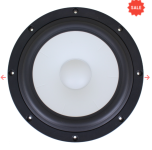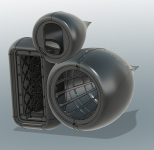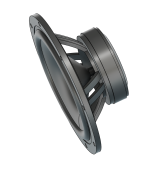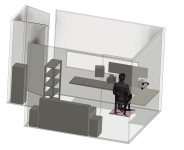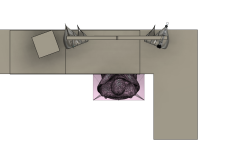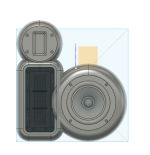Some of you know I'm making some monitors for my office. I've been playing with mostly 6" drivers with plans to vent them. Well, Madisound put the 8" version of SB Acoustics Ceramic on sale and it looks like it will work.
Question is if I can get away with this for nearfield listening? I'll be crossing at 800 hz. I can cross a bit lower at 650-700 if needed. I know there is some calculation for how close drivers need to be to meld for nearfield. Does anyone know it well and can explain to me how that works, if this would work, and why?
Also, my baffle will be tiny. And I mean TINY. This whole thing I want to fit in the 350mm cubed print bed of my new 3d printer. Its probably a good restriction since it will force me to keep all the drivers very close together.
Here is the driver in question:
https://www.madisoundspeakerstore.c...oustics-sb23cacs45-8-8-ceramic-woofer-8-ohms/
Here is Joseph Explaining that it will work well within the range I plan to use it. I do plan to use it sealed. My enclosure will only be 0.5 cubic foot. That should be enough I think
https://josephcrowe.com/blogs/news/sb-acoustics-sb23nbacs45-8-8-woofer-review
Question is if I can get away with this for nearfield listening? I'll be crossing at 800 hz. I can cross a bit lower at 650-700 if needed. I know there is some calculation for how close drivers need to be to meld for nearfield. Does anyone know it well and can explain to me how that works, if this would work, and why?
Also, my baffle will be tiny. And I mean TINY. This whole thing I want to fit in the 350mm cubed print bed of my new 3d printer. Its probably a good restriction since it will force me to keep all the drivers very close together.
Here is the driver in question:
https://www.madisoundspeakerstore.c...oustics-sb23cacs45-8-8-ceramic-woofer-8-ohms/
Here is Joseph Explaining that it will work well within the range I plan to use it. I do plan to use it sealed. My enclosure will only be 0.5 cubic foot. That should be enough I think
https://josephcrowe.com/blogs/news/sb-acoustics-sb23nbacs45-8-8-woofer-review
Attachments
Hi,
to my knowledge, being nearfield of a speaker (technically, not the studio nearfield monitoring term) means sound that changes a lot if you move, it could get quieter or louder at any given frequency if you move bit closer/further, or just move in general. This is due to sound emitting at various parts of the speaker have relatively big distance differences to ear, which change a lot if you move a little changing resulting interference and thus sound. The further you are, the more equidistant all the sound emitting parts are, so sounb doesn't change that much with the same amount of movement.
Simple rule of thumb regarding where speaker nearfield ends and farfield starts is 4x the longest dimension of your speaker, or something along the lines. If your spraker has no secondary sounds you'd take diameter of largest driver, or c-c. But I think you can really just figure out how much you move, and how to build a speaker which has "uniform" sound for that amount of movement at the distance you listen at. For example, I think any good speaker should address edge diffraction somehow and have good enough structure so that there is not much secondary sounds, which leaves only the transducers emitting sound.
If you did good job with the design horizontal coverage is likely fine (drivers stacked) for quite big listening window, but vertical isn't around the crossover. If you can put the speakers at ear height, and if your ear height is quite constant, this doesn't matter. If your speakers are on a table, below ear height, you might want to make them tilt or try and make the main lobe at crossover wide, which basically means coaxial sources if you really optimize. And, just in case, make sure the system is no bigger than listening distance / 4. Or what ever rule of thumb you have picked up 🙂
Anyway, practical implications are about sound changing when you move as you listen, and in the design phase you must measure at far field not to overcompensate some nearfield effect thats not happening at actual listening distance.
Near and far field have many definitions, or uses, in forums at least. Near/far field of a speaker where sound of the speaker transitions from chaotic to more uniform, as above. Then there is near/far field of the whole system regarding room sound, which is what the studio monitoring terms are also about, near field being where direct sound is louder than room sound. And I've mistakenly expanded some time ago to perceived near/farfield as well, where auditory system switches state, before I found out it's Limit of Localization Distance named by Griesinger 😀 So, watch out with the terminology, make sure you understand which one of these you mean when talking about near/far field. Slso make sure which one people mean when you read their messages.
to my knowledge, being nearfield of a speaker (technically, not the studio nearfield monitoring term) means sound that changes a lot if you move, it could get quieter or louder at any given frequency if you move bit closer/further, or just move in general. This is due to sound emitting at various parts of the speaker have relatively big distance differences to ear, which change a lot if you move a little changing resulting interference and thus sound. The further you are, the more equidistant all the sound emitting parts are, so sounb doesn't change that much with the same amount of movement.
Simple rule of thumb regarding where speaker nearfield ends and farfield starts is 4x the longest dimension of your speaker, or something along the lines. If your spraker has no secondary sounds you'd take diameter of largest driver, or c-c. But I think you can really just figure out how much you move, and how to build a speaker which has "uniform" sound for that amount of movement at the distance you listen at. For example, I think any good speaker should address edge diffraction somehow and have good enough structure so that there is not much secondary sounds, which leaves only the transducers emitting sound.
If you did good job with the design horizontal coverage is likely fine (drivers stacked) for quite big listening window, but vertical isn't around the crossover. If you can put the speakers at ear height, and if your ear height is quite constant, this doesn't matter. If your speakers are on a table, below ear height, you might want to make them tilt or try and make the main lobe at crossover wide, which basically means coaxial sources if you really optimize. And, just in case, make sure the system is no bigger than listening distance / 4. Or what ever rule of thumb you have picked up 🙂
Anyway, practical implications are about sound changing when you move as you listen, and in the design phase you must measure at far field not to overcompensate some nearfield effect thats not happening at actual listening distance.
Near and far field have many definitions, or uses, in forums at least. Near/far field of a speaker where sound of the speaker transitions from chaotic to more uniform, as above. Then there is near/far field of the whole system regarding room sound, which is what the studio monitoring terms are also about, near field being where direct sound is louder than room sound. And I've mistakenly expanded some time ago to perceived near/farfield as well, where auditory system switches state, before I found out it's Limit of Localization Distance named by Griesinger 😀 So, watch out with the terminology, make sure you understand which one of these you mean when talking about near/far field. Slso make sure which one people mean when you read their messages.
Unfortunately, if the speakers are those plastic printed boxes, it's not gonna work.
The auditory bla bla needs the contribution of each source to be stacked vertically on central axis.
The so called compromises happen when you follow some crazy idea
You can win if you play following the rules, which are basic but admit no deviation. The choice of a big woofer is no good for nearfield. In this situation it's more complicated because the design appeals and there might be 1us when they sound good for the matter of refraction, diffraction, reflection them diffusion... traveling.
The auditory bla bla needs the contribution of each source to be stacked vertically on central axis.
The so called compromises happen when you follow some crazy idea
You can win if you play following the rules, which are basic but admit no deviation. The choice of a big woofer is no good for nearfield. In this situation it's more complicated because the design appeals and there might be 1us when they sound good for the matter of refraction, diffraction, reflection them diffusion... traveling.
Ok, this is helpful.Hi,
to my knowledge, being nearfield of a speaker (technically, not the studio nearfield monitoring term) means sound that changes a lot if you move, it could get quieter or louder at any given frequency if you move bit closer/further, or just move in general. This is due to sound emitting at various parts of the speaker have relatively big distance differences to ear, which change a lot if you move a little changing resulting interference and thus sound. The further you are, the more equidistant all the sound emitting parts are, so sounb doesn't change that much with the same amount of movement.
Simple rule of thumb regarding where speaker nearfield ends and farfield starts is 4x the longest dimension of your speaker, or something along the lines. If your spraker has no secondary sounds you'd take diameter of largest driver, or c-c. But I think you can really just figure out how much you move, and how to build a speaker which has "uniform" sound for that amount of movement at the distance you listen at. For example, I think any good speaker should address edge diffraction somehow and have good enough structure so that there is not much secondary sounds, which leaves only the transducers emitting sound.
If you did good job with the design horizontal coverage is likely fine (drivers stacked) for quite big listening window, but vertical isn't around the crossover. If you can put the speakers at ear height, and if your ear height is quite constant, this doesn't matter. If your speakers are on a table, below ear height, you might want to make them tilt or try and make the main lobe at crossover wide, which basically means coaxial sources if you really optimize. And, just in case, make sure the system is no bigger than listening distance / 4. Or what ever rule of thumb you have picked up 🙂
Anyway, practical implications are about sound changing when you move as you listen, and in the design phase you must measure at far field not to overcompensate some nearfield effect thats not happening at actual listening distance.
Near and far field have many definitions, or uses, in forums at least. Near/far field of a speaker where sound of the speaker transitions from chaotic to more uniform, as above. Then there is near/far field of the whole system regarding room sound, which is what the studio monitoring terms are also about, near field being where direct sound is louder than room sound. And I've mistakenly expanded some time ago to perceived near/farfield as well, where auditory system switches state, before I found out it's Limit of Localization Distance named by Griesinger 😀 So, watch out with the terminology, make sure you understand which one of these you mean when talking about near/far field. Slso make sure which one people mean when you read their messages.
I can place them far back enough on the desk as to meet the 4x rule. I can also mount them above pointed down but that might cause issues with reflections off of the desk. We had that issue with my friend's monitors when we did that. Started getting reflections at 1500 hz. Table was too close.
The issue with stacking horizontal is that Ideally I would have them placed underneath my top two monitors. I could stack them but then I would have to push them pretty far out to the side. They would be pretty narrrow stacked so I guess that is doable. I would just have to print them one box at a time and screw them together. The issue with that is it isn't as strong. I have a laser cutter though so I can make closed celled gaskets. It would for sure be sealed.
My current monitor two way that I built has the woofer and tweeter not aligned vertically. I can hear the sound change as I move about. However, it is only one speaker running mono so this increases the issue hugely. I feel like stereo doesn't end up with the the same issues.
I've attached picture of the CAD of my office. This way people understand what it is I am talking about.
Attachments
Pico,
You have issue with plastic enclosures? Interesting. I've make some really good speakers and almost every one of them uses a 3d printed part of one sort of another. CAD and 3d printing allows you so much more freedom of design. As long as you know how to control the ringing of the plastic they are just as good as wood. They certainly are more structurally sound. A flat board is about the least structurally sound shape in the world.
You have issue with plastic enclosures? Interesting. I've make some really good speakers and almost every one of them uses a 3d printed part of one sort of another. CAD and 3d printing allows you so much more freedom of design. As long as you know how to control the ringing of the plastic they are just as good as wood. They certainly are more structurally sound. A flat board is about the least structurally sound shape in the world.
This blue box here is my print bed. If I go beyond it I must print in multiple pieces. This is a LARGE print volume by the way. Most people do not have 350mm cubed to play with.
If I align them it will look like this at the desk. This does make the mid and tweeter at ear level........hmmmmm.....
Any have any thoughts on turning the planar 90 degrees? Maybe I will take some measurements and see what that does to its dispersion pattern
If I align them it will look like this at the desk. This does make the mid and tweeter at ear level........hmmmmm.....
Any have any thoughts on turning the planar 90 degrees? Maybe I will take some measurements and see what that does to its dispersion pattern
Attachments
Yeah it's not that critical, sound changes anyway as one moves, just due to HRTF. Also if your position stays relatively constant almost anything goes, as long as you can optimize sound for the spot. If you are serious though, trying to get very good near field sound, put the speakers ear height or use some coaxial configuration. Even small fullrange speakers can sound quite nice nearfield. If you are set to build a three way system I say go ahead since that's great excersize on a lot of things, from manufactuting to measurements to listening the results and so on, not a waste of time. After all, it's the same no matter what the speakers are, and you can only better what you know doesn't work and until then the latest build is best there can be!🙂 Bandwidth and SPL requirement, measure the distances and listening area size where your head is, and just make a system that delivers itthese very basic requirements. There is many ways to get the job done, but one should always make speakers what ever you fancy, because that will keep you motivated and help finish the project while having fun all the time!🙂
Last edited:
My thoughts exactly. If it sounds bad or I don't like it I can always just print another box.
I think the 3d printed box allows me a lot more R&D with these. I do not particularly like the wooden box building portion of this hobby. If I can take that away for this build it would be a lot more fun for me.
I can try vertical alignment and offset and see how they do in the sims.
Luckily I bought all this filament super cheap so it only costs $18 to print out one of these huge enclosures.
I think the 3d printed box allows me a lot more R&D with these. I do not particularly like the wooden box building portion of this hobby. If I can take that away for this build it would be a lot more fun for me.
I can try vertical alignment and offset and see how they do in the sims.
Luckily I bought all this filament super cheap so it only costs $18 to print out one of these huge enclosures.
Generally we (at least me..) move more left and right than vertically when seated, so you would be in and out of the tweeter pattern with small head movements the planar is turned 90 degrees.Any have any thoughts on turning the planar 90 degrees? Maybe I will take some measurements and see what that does to its dispersion pattern
Since your video monitor positions puts the tweeters well below head level, you will want to point them up to ear level. You won't need measurement to hear that, but it's fun to confirm what's actually happening 😉 .
I'd suggest a flat front monitor (tweeter and mid vertically aligned) pointing up at the same angle as the lower video monitor, which would avoid the "hash" produced by diffraction reflections off the lower and upper video monitors with ovoid enclosures.
Art
Weltersys,
My idea for the ovoid enclosures came from the diffraction experiments I did with the Dark Series 2 ways. I was able to greatly reduce the off axis roll off response with a more gradual radius. This takes that to a more extreme level. I figured it would be good for nearfield so that moving my head doesn't have a huge impact on the sound.
The current monitor is small drivers with a relatively big baffle. The big flat baffle makes it highly directional. Good for keeping the sound of my music in my office. Bad for actual listening. I actually setup the Dark Series in my office for one day. Its off axis was so good that you could hear the music everywhere in the shop.
I put my new office in the corner so I won't bother anyone anymore with my music (not that anyone complained, I try to not be an annoying boss though)
I figured as much with this. I might still test it just to see how much different it is horizontal vs vertical dispersion. Easy enough to model and print out a rig to do it. Fun experiment. Its winter, I am bored.Generally we (at least me..) move more left and right than vertically when seated, so you would be in and out of the tweeter pattern with small head movements the planar is turned 90 degrees.
Yes, I planned on doing this. Ideally the mount allows for different angle adjustments so I'm not married to one position. Easy enough to model and print.Since your video monitor positions puts the tweeters well below head level, you will want to point them up to ear level. You won't need measurement to hear that, but it's fun to confirm what's actually happening 😉 .
This I do not understand. What is the "hash"?I'd suggest a flat front monitor (tweeter and mid vertically aligned) pointing up at the same angle as the lower video monitor, which would avoid the "hash" produced by diffraction reflections off the lower and upper video monitors with ovoid enclosures.
My idea for the ovoid enclosures came from the diffraction experiments I did with the Dark Series 2 ways. I was able to greatly reduce the off axis roll off response with a more gradual radius. This takes that to a more extreme level. I figured it would be good for nearfield so that moving my head doesn't have a huge impact on the sound.
The current monitor is small drivers with a relatively big baffle. The big flat baffle makes it highly directional. Good for keeping the sound of my music in my office. Bad for actual listening. I actually setup the Dark Series in my office for one day. Its off axis was so good that you could hear the music everywhere in the shop.
I put my new office in the corner so I won't bother anyone anymore with my music (not that anyone complained, I try to not be an annoying boss though)
Since you’re printing it, take this even further and design something that integrates well acoustically with the surroundings of front wall, monitors and desktop. Think of in-wall. Enclosure resonances or driver alignment aren’t exactly your biggest challenges here. Early reflections and comb filters are though.I'd suggest a flat front monitor (tweeter and mid vertically aligned) pointing up at the same angle as the lower video monitor, which would avoid the "hash" produced by diffraction reflections off the lower and upper video monitors with ovoid enclosures.
Early reflections and comb filtering from video monitor reflections.What is the "hash"?
A big baffle limits dispersion to 180 degrees for wavelengths smaller than the baffle, not directional compared to your tweeter's vertical dispersion.The current monitor is small drivers with a relatively big baffle. The big flat baffle makes it highly directional.
Oh yes, I am well aware of this. With the space being so narrow reflections are going to be an issue. The reason this is my office is because it's such an odd space. It made no sense to knock the walls down for manufacturing floor space. So I just turned it into my office.Since you’re printing it, take this even further and design something that integrates well acoustically with the surroundings of front wall, monitors and desktop. Think of in-wall. Enclosure resonances or driver alignment aren’t exactly your biggest challenges here. Early reflections and comb filters are though.
I built sound traps for my living room which made a big difference. I will probably do something similar here.
I'm not very well versed in room reflections and how to deal with them on the loudspeaker design side. I've taken RTA measurements of my cars and some rooms with REW. It seems to just always show a giant hump in the mid range. I have tried EQ to bring up both ends but I just never liked the sound.
So I've just been designing systems for a flat initial response and letting the room do what it wants. I am not skilled enough currently to do otherwise.
Everything in the nearfield is proportionally larger. A 8 inch driver is larger to start with, then the enclosure is even larger still.
Nearfield or direct-field is normally done on the desktop or benchtop. 8 inch drivers and the required 30 L enclosures are beyond what will fit in my face on my bench top.
If you want to move more air use a longer stroke, higher tech 6 inch Purifi mid-woofer in your nearfield. F3 is ~ 80Hz
On my bench I use 6 inch Purifi drivers in 15 L enclosures with a single 12 inch XXLS sub-woofer tucked under the bench.
Thanks DT
Nearfield or direct-field is normally done on the desktop or benchtop. 8 inch drivers and the required 30 L enclosures are beyond what will fit in my face on my bench top.
If you want to move more air use a longer stroke, higher tech 6 inch Purifi mid-woofer in your nearfield. F3 is ~ 80Hz
On my bench I use 6 inch Purifi drivers in 15 L enclosures with a single 12 inch XXLS sub-woofer tucked under the bench.
Thanks DT
I am hoping I can avoid this by pointing the system straight at my head. This is part of the reason I want to keep all the driver as close together as possible.Early reflections and comb filtering from video monitor reflections.
It will fit. I've already modeled it. It won't be taking up any more space than the 6". A 6" ported and an 8" sealed use about the same enclosure volume.Everything in the nearfield is proportionally larger. A 8 inch driver is larger to start with, then the enclosure is even larger still.
I'm not spending purifi money on this. The other drivers I'm using are $60 and $65 respectively.
Where did you source the Peerless from?On my bench I use 6 inch Purifi drivers in 15 L enclosures with a single 12 inch XXLS sub-woofer tucked under the bench.
I tried to find those but couldn't find anywhere that didn't have a minimum order quantity
If you have made up your mind stop asking and just do it.
You will find that space does matter in the near field. If you like the SB Acoustics ceramic drivers try the SB17ACA35-8 they will be half the space on the desktop. Cross them over to the sub under the desk a little higher, like 125-150Hz. Keep the low sub frequencies out of the mid drivers to limit the IM Distortion.
Thanks DT
You will find that space does matter in the near field. If you like the SB Acoustics ceramic drivers try the SB17ACA35-8 they will be half the space on the desktop. Cross them over to the sub under the desk a little higher, like 125-150Hz. Keep the low sub frequencies out of the mid drivers to limit the IM Distortion.
Thanks DT
Where did you source the Peerless from?
I tried to find those but couldn't find anywhere that didn't have a minimum order quantity
I bought them a couple of years ago from Digikey.
Thanks DT
- Home
- Loudspeakers
- Multi-Way
- 8" Driver for Nearfield? Can I get away with this?
